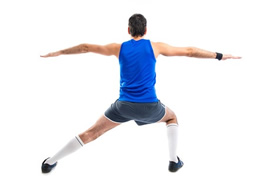Recommended Exercises for Sports Hernia Prevention or Recovery
 A sports hernia is a lesser-known injury that has the potential to cause chronic, debilitating pain and sideline you from the most basic of life’s activities. It can strike professional athletes and amateurs alike, so it’s important for athletes at all levels to work toward recovering sports hernias, or better yet, preventing one in the first place. There are numerous sports hernia prevention exercises and stretches that can reduce your risk of injury.
A sports hernia is a lesser-known injury that has the potential to cause chronic, debilitating pain and sideline you from the most basic of life’s activities. It can strike professional athletes and amateurs alike, so it’s important for athletes at all levels to work toward recovering sports hernias, or better yet, preventing one in the first place. There are numerous sports hernia prevention exercises and stretches that can reduce your risk of injury.
A sudden twisting movement often causes a sports hernia injury. Common sports such as hockey, soccer, or dance involve these twisting movements, but they also occur during everyday activities. Before beginning any athletic or strenuous activity, STRETCH!
Specific muscles can become more flexible with repetitive stretching, increasing their flexibility and making them less prone to injury. A standing groin stretch can be particularly effective, since it focuses on the muscles where a sports hernia is likely to occur. The stretch is simple to perform, just spread legs into a wide stance and bend one knee, leaning sideways. Holding for 20-30 seconds and then repeating a few times a day will help to improve your flexibility. Another popular stretch is the butterfly stretch, which is performed in a seated position. With your back straight, touch the soles of your feet together and place your knees on your elbows while bringing your feet closer to you. This adductor stretch strengthens the inside groin area, where sports hernia injuries occur.
In addition to stretching, regular exercise that targets the core can help to maintain a strong base, which protects against injury. Exercises like crunches and planks can help build resistance. Lunges are also a great approach to strengthening your lower abdomen and groin area simultaneously. To perform a lunge with the maximum benefit, correct form is essential. Your back must be straight, and your feet in line with your shoulders and knees. Ideally, at the farthest point, your knee should form a 90° angle with the floor but never deeper than that to avoid risk of injury.
These stretches and exercises not only prevent a sports hernia injury, but also they can help those in the recovery stages post sports hernia surgery. They strengthen the right muscle groups to prevent injury from happening again. After a course of individualized physical therapy, continuing to perform these exercises while returning to activity can make recovery smoother sailing.
Using a balance board is also very helpful as it helps your muscles learn to coordinate their contractions.
